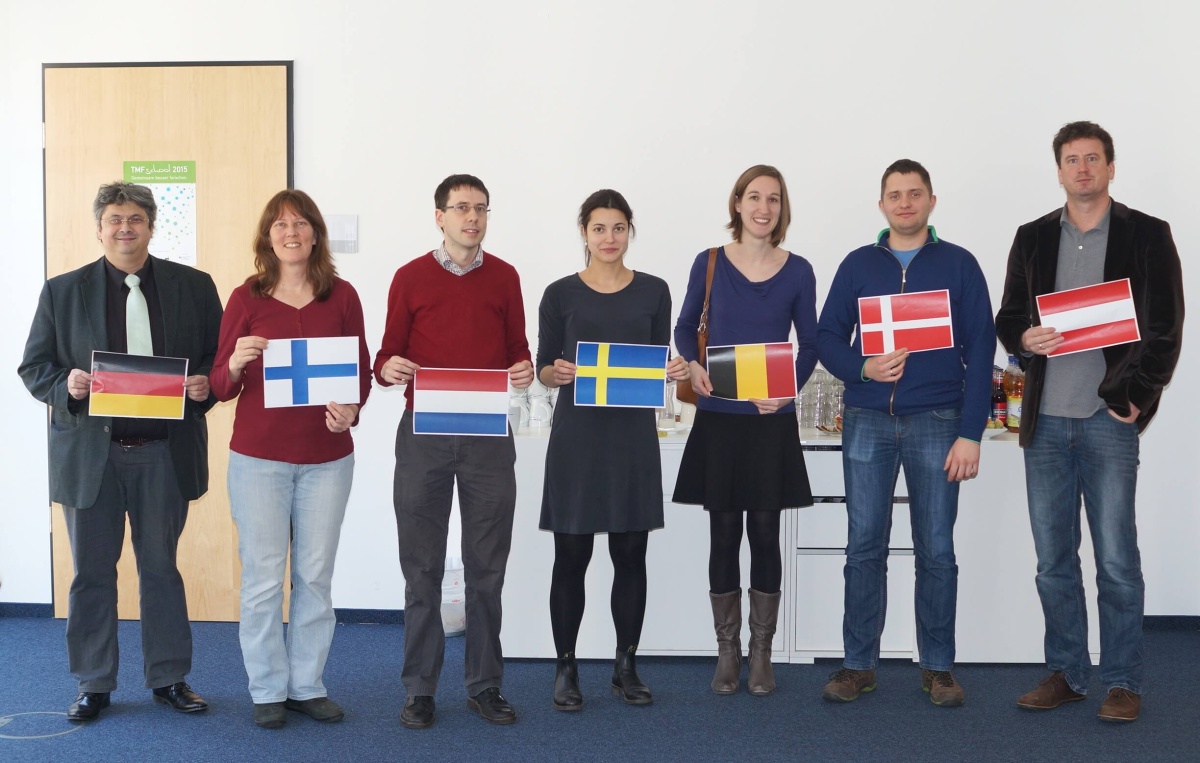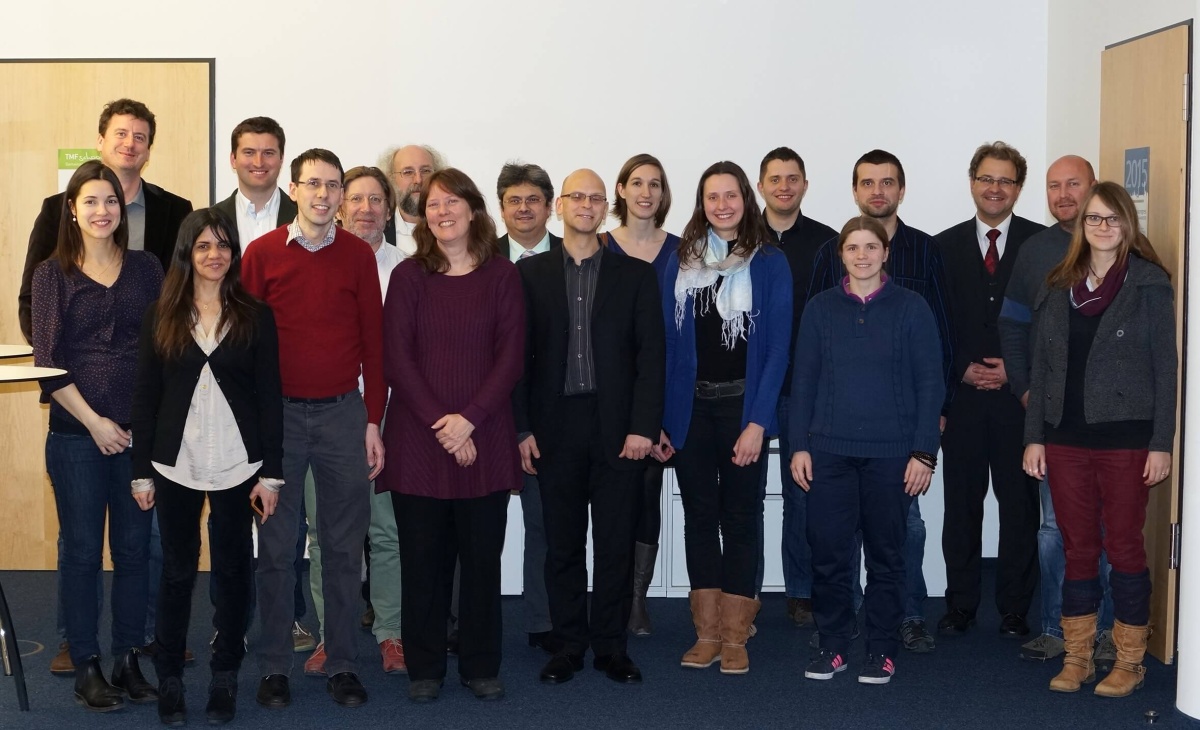Biobank registries in Europe struggle with similar challenges

The biobank registry speakers (f.l.t.r.): Roman Siddiqui (German Biobank Registry), Kaisa Silander (Finnish Biobank Network, KITE, BBMRI.fi), David van Enckevort (Catalogue of Biobanks, BBMRI.nl), Loreana Norlin (Sample Collection Register, BBMRI.se), Annelies Debucquoy (Belgian Cancer Registry, BBMRI.be), Bartlomiej Wilkowski (Danish National Biobank Register), Horst Pichler (BBMRI.at-Platform) © TMF e.V.
National biobank registries throughout Europe prefer to establish “structured yellow pages” in order to make their countries’ biobank resources visible. Some of them also focus on additionally establishing “sample locators” as a means to foster scientific collaboration. However, all registries face similar challenges in achieving completeness of registration. This became apparent during the meeting of the biobank registries from seven European countries on 18th and 19th February 2015 in Berlin. Incentives for registration set by the national governments could greatly facilitate the process. The participants of the meeting expressed the wish to have more communication between them at the working level.
Seven national biobank registries and several representatives from academic institutions as well as from the European biobank infrastructure BBMRI-ERIC followed the invitation of the German Biobank Registry which is run by the TMF. The aim of the meeting was to mutually learn from the different approaches of the registries and to discuss aspects of standardization and quality. Due to the diverse historical, political and regulative situation in Austria, Belgium, Denmark, Finland, the Netherlands, Sweden, and Germany, biobank registries have evolved quite differently in these countries.
Legal obligation to register biobanks
In some countries, laws demand the registration of biobanks. This is, for instance, true for Finland, as Kaisa Silander (National Institute for Health and Welfare, Finland) explained. The Biobank Act, which came into force in September 2013, aims at promoting openness in the use of human biological samples and allows wide consent which may also be applied to old sample collections. By end of 2015, nine large biobanks that are being established simultaneously will be registered in the Finnish Biobank Network BBMRI.fi.
Sweden as well has a legal obligation for biobanks to register: Any sample stored in health care biobanks needs to be registered in the Swedish Biobank Registry (SBR) at the National Board of Health and Welfare. The aim is to be able to find samples in case of consent withdrawal. However, as Loreana Norlin and Roxana Merino Martinez (Karolinska Institutet, Sweden) pointed out, no diagnosis and clinical information or linkage to other registers is available in the SBR. This is why in 2012 the BBMRI.se register was launched to gather meta-data on sample collections and research studies using human biological samples, including diagnosis and clinical information on a meta level. The BBMRI.se register – building on the first version of the standard vocabulary MIABIS discussed later during the meeting – currently covers 114 sample collections with samples from approximately 1.4 million donors. But as Loreana Norlin said it was tough to get the register started and keep the people motivated in pursuing to populate the register with their data. In the very near future a new register will be built in Sweden.
Some countries have more than one registry
Belgium even has three Biobank registries: The Belgium Virtual Tumourbank (BVT), the Biothèque de la Fédération Wallonie-Bruxelles, and the Flemish biobanking initiative CMI, as Annelies Debucquoy from the BVT, and, in her function as the representative of the Belgian Biobank Consensus Platform explained. In Belgium, interestingly, biobanks get financial support from the government, for example to register in the BVT, which is a very strong motivation for the sake of completeness. The three registers aim at creating a Belgian Virtual Biobank Catalogue in compliance with BBMRI-ERIC guidelines by the end of 2015. The harmonization of the dataset for registration of the samples has already been achieved. However, access to the data is restricted to those who have a Belgian ID and even only after registration.
In contrast, Denmark enjoys a very open access policy. As Bartlomiej Wilkowski (Statens Serum Institute, Denmark) pointed out the Biobank Register at the Danish National Biobank has been launched in 2013 and integrates data from various Danish registers and biobanks. Motivations for the initiative were to provide information on existing samples for epidemiological register-based research and to support clinical hospital biobanks. The biobank register system will allow to track diagnoses and samples of individuals throughout their lives so that biomarkers may be detected in earlier samples if a person develops a specific disease later on. 16.3 million samples from 5.1 million donors are openly searchable by researchers from all over the world.
Searching for samples
The Austrian BBMRI.at Platform also aims at providing not only aggregated data on biobanks and sample collections but also discusses how information on samples, donors and molecular data may be accessed in future. Horst Pichler (University of Klagenfurt, Austria) presented the data model and explained that the data are administered by the ten Austrian biobank partners. The Austrian platform uses Liferay, which will also being used by the upcoming new Swedish register and has been applied by the German Biobank Registry as well. This enables knowledge sharing and mutual support for future IT developments between the registries.
An alternative approach to the administration of data by the biobanks may be to provide the facilities for an automated import from a local biobank catalogue. This is what the BBMRI.nl initiative tries to achieve in order to connect the more than 200 biobanks that exist in the Netherlands. However, as David van Enckevort (University Medical Center Groningen, Netherlands) explained, at the moment the catalogue is rather a basic list of biobanks.
Soft incentives are not enough
Roman Siddiqui (TMF) stressed the aspects of avoiding redundant research and transparency as two of the main purposes for a structured “yellow page” catalogue of national biobanks. However, even if biobank leaders do agree with these arguments, this does not always result in them registering their biobank. The seven European biobank register representatives agreed that altruism will not be the driving force in guaranteeing the completeness of the registries. Regulatory or funding policies provided by governments, funding organizations or also journals would be much more effective.
In Germany, this was very obvious in 2010 when a tender initiative by the Ministry of Research and Education to build centralized biobanks at university hospitals requested the registration of the biobanks prior to application: In only a few days before submission deadline 79 biobanks registered in the German Biobank Registry. As discussed, the meeting participants concluded that the European Biobank Infrastructure (BBMRI-ERIC) should strengthen its support to the national register initiatives by giving official advice to the governments, to include their register infrastructures within their policies.
A standard vocabulary for biobank registries
In order to facilitate communication between biobank registries and to stimulate cross-border research collaborations the “Minimum Information About Biobank data Sharing” (MIABIS) has been developed as a guideline which several of the biobank registries already use for their data models. The first version of the data set has been developed and published by BBMRI.se in 2012.
A MIABIS working group was established in 2013 and MIABIS 2.0 Core released in November 2014. “There has definitely been a need for an ontology” Loreana Norlin said, as there is a lot of interest in the working group. The results are available on the MIABIS wiki page [bbmri-wiki.wikidot.com/en.dataset] and will be published in due course.
Quality standards are still widely unknown
Daniela Skrowny (University Medicine Goettingen) presented two standards for quality in biobanks: BRISQ (Biospecimen Reporting for Improved Study Quality) is intended for clinical biobanks and used to describe the quality of the whole study rather than the quality of single samples. The journal Nature already recommends referring to the BRISQ reporting guidelines. SPREC (Sample Pre-analytical Code) is used to document the quality of samples where pre-analytical factors are coded in seven fields. A limitation is that this standard does not take into account sample processing. However, according to Daniela Skrowny, the main problem is that BRISQ as well as SPREC still are too much unknown in the scientific biobank community.
As an example of how process quality of biobanks may be defined and captured Robert Reihs (Medical University Graz, Austria) presented RD-Connect, a platform to connect databases, registries, biobanks and clinical bioinformatics for rare diseases. Amongst other things the portal enables the mapping of different Standard Operating Procedures used in the different resources.
Still an open question is how information on quality should be displayed in a biobank register. The participants agreed that it will be impossible to provide a complete picture for each single biobank in the register. Rather the biobanks should check a box in the register to confirm that they are able to describe their quality processes in a standardized manner. Registries could then provide a service to facilitate the communication between the requesting researcher and the biobank.
Define a real use case before building a specimen locator
The possible role of Unique Biobank Identifiers and challenges of their generation were also discussed vividly during the meeting. Different systems do already exist at the national levels. The suggestion was made that the national registries could be the entity to supply biobank IDs. These unique identifiers would be especially important when building a specimen locator at the European level as BBMRI-ERIC intends to do.
Given the diversity of the legal and technical conditions in the European countries, establishing an overarching specimen locator will be a difficult task. Petr Holub (BBMRI-ERIC, Graz) pointed out that a clear definition of a real use case would be needed before starting to develop something. Overall, the participants of the meeting agreed that providing aggregate information on biobanks at the country as well as on the European level still is very important.
The European biobank infrastructure should acknowledge and build on what is already available in the countries. Cooperation should also be sought with international partners beyond Europe as well as with infrastructures from other fields of medical research.

Group picture (f.l.t.r.): Loreana Norlin (Karolinska Institutet, Stockholm, Sweden), Horst Pilcher (University of Klagenfurt, Austria), Roxana Merino Martinez (Karolinska Institutet, Stockholm, Sweden), Robert Reihs (Medical University of Graz, Austria), David van Enckevort (UMCG, Groningen, Netherlands), Heimo Müller (Medical University of Graz, Austria), Jörg Geiger (University Hospital, Würzburg, Germany), Kaisa Silander (National Institute for Health and Welfare, Helsinki, Finland), Roman Siddiqui (TMF e.V., Berlin, Germany), Mathias Wieland (University Hospital Heidelberg, Germany), Annelies Debucquoy (Belgian Cancer Registry - BBMRI, Belgium), Ines Leb (FAU Nürnberg-Erlangen, Germany), Bartlomiej Wilkowski (Statens Serum Institut, Copenhagen, Denmark), Daniela Skrowny (Medical University of Göttingen, Germany), Petr Holub (BBMRI-ERIC, Graz, Austria), Sebastian Claudius Semler (TMF e.V., Berlin, Germany), Guy Redding (Fraunhofer IZI, Leipzig, Germany), Katharina Zoldan (Fraunhofer IZI, Leipzig, Gemany) © TMF e.V.
Downloads
Programm Details
| Attachment | Size |
|---|---|
| Programmflyer (pdf, 849.76 KB) |
Workshop Presentations
| Attachment | Size |
|---|---|
| 02. Horst Pichler: Catalogue of Austrian Biobanks (pdf, 2.27 MB) |
| Attachment | Size |
|---|---|
| 04. Bartłomiej Wilkowski: Danish National Biobank (pdf, 1.48 MB) |
| Attachment | Size |
|---|---|
| 05. Kaisa Silander: Biobank registers in Finland (pdf, 2.3 MB) |
| Attachment | Size |
|---|---|
| 08. Roman Siddiqui: German Biobank Registry (pdf, 2.06 MB) |


